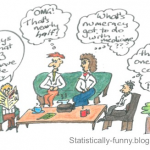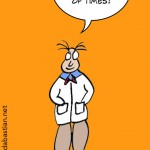Format:
Cartoons,
Language/s:
English,
Target Audience:
Self-directed learning |
Short Description:
Even 'experts' can be uninformed.
Key Concepts addressed:
Details
It doesn’t come as a terrible shock to hear that a lot of patients struggle with statistics . It’s a little more scary, though, to be reminded that doctors’ understanding of health statistics and data on screening isn’t all that fabulous either. And now this month we hear that “a considerable proportion of researchers” don’t understand routinely used statistical terms in systematic reviews. Gulp.
We’ve probably only been scratching the surface of what can be done to improve this. Arecent small trial found that hyperlinking explanations to statistical and methodological terms in journal articles could improve physicians’ understanding. (That’s something we’ve started doing at PubMed Health . Although it’s early days yet for us with coverage, they’re getting clicked on quite a bit.)
Statistical literacy needs a combination of literacy, mathematical, and critical skills (PDF ). In communication, numbers will always be tangled up with words (and sometimes words are better, as I discuss here ).
Journalists are key to helping turn this problem around. They probably aren’t getting the training they need, according to this study from 2010 – but that might be improving…slowly . Thankfully, Frank Swain from the Royal Statistical Society reports encouragingly on journalists’ desire to learn more about statistics in the era of data journalism.
Want to learn more about basic statistics in health studies? Trials show that reading this book, Know Your Chances , could help.
And if you’re wondering about how your own mathematics competency is faring since you left school, here’s an online test . Mind you, it would help a lot if we had a clearer way of communicating numbers. The confusion over what means mean is a good case in point, covered here at Statistically Funny .
Cartoons are available for use, with credit to Hilda Bastian.
Browse Key Concepts
Back to Library
Jargon buster
Select a term acceptability
adherence
adverse effect
adverse event
allocation
allocation bias
allocation schedule
allocation schedule concealment
applicability
association
attrition bias
average
average difference
baseline characteristics
before-after study
benefit
bias
blinding
burden
case report
case series
case-control study
causal association
certainty of the evidence
change in cost
cluster
cluster randomized study
cohort study
comparative study
comparing like with like
confidence interval
confidence region
confirmation bias
conflicts of interests
confounders
contamination
controlled before-after study
controlled study
cost
cost-effectiveness
critical assessment
cross-sectional study
crossover study
cut-off value
data collection
data fishing
diagnosis
diagnostic algorithm
diagnostic odds ratio
diagnostic test
diagnostic test accuracy
difference
direct comparison
disease progression bias
disease stage
disease status
double blinding
double dummy
dramatic treatment effect
drug
effect estimate
effectiveness
efficiency
eligibility criteria
enrolment
estimate
evidence
evidence profile
evidence to decision framework
explanatory trial
exploratory analysis
extrapolated evidence
factorial study
fair comparisons of treatments
false negative test result
false negative test result (duplicate)
false positive test result
false positive test result (duplicate)
follow-up
forest plot
GRADE
guideline
high certainty of the evidence
important
imprecision
incidence
inconsistency
incremental cost-effectiveness ratio
indeterminate diagnostic test result
index test
indicator
indirect comparison
indirectness
informed consent
intention-to-treat analysis
interim analysis
interrupted time series study
lead-time bias
length-time bias
level of evidence
likelihood
likelihood ratio
loss to follow-up
low certainty of the evidence
low risk of bias
measurement bias
meta-analysis
minimization
moderate certainty of the evidence
modified intention-to-treat analysis
monitoring
multicentre study
multiple statistical comparisons
natural course of health problems
negative predictive value
nocebo effect
non-random allocation
non-randomized study
number needed to harm
number needed to screen
number needed to treat
objective outcome
odds
odds ratio
outcome
outcome measured on a scale
overdiagnosis
overtreatment
p-value
paired study design for diagnostic tests
parallel group study
peer review
performance bias
perspective
phase 1 trial
phase 2 trial
phase 3 trial
phase 4 trial
PICO
placebo
placebo effect
planned analysis
play of chance
positive predictive value
pragmatic trail
pre-test probability
precision
prevalence
primary outcome
prognosis
prognostic variable
protocol or study plan
qualitative study
quality-adjusted life years
quantitative study
random
random allocation
randomized study
reference standard test
regulation of research
relative effect
reliability
repeated measures study
reporting bias
reproducibility
research
research data
research evidence
research methods
research priorities
resource use
risk of bias
risk ratio
sample
sample size
scale
screening
screening test
secondary outcome
selection criteria
sensitivity
shared decision making
single blinding
single participant trial
smallest important difference
specificity
spin
sponsor bias
statistical power
statistically significant
stratified randomization
strength of recommendation
study
study participants
study population
subgroup
subgroup analysis
summary of findings
surrogate outcome
systematic review
target condition
theory
time horizon
treatment
treatment comparison
treatment comparison group
treatment effect
treatment effect
trial phases
triple blinding
true negative test result
true positive test result
type of study
uncertainty
under-reporting
undesirable effect
unfairness
unit of analysis error
utility value
value
variables
very low certainty of the evidence
yes/no outcomes
About GET-IT
GET-IT provides plain language definitions of health research terms




